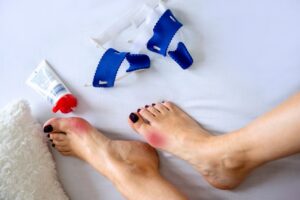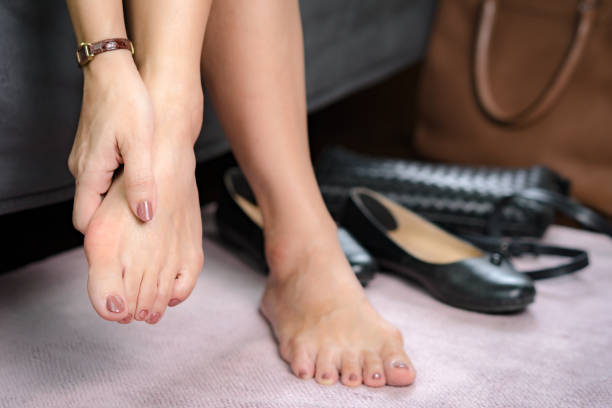Bunions Got You Down? Treatment Options and Relief Strategies
Bunions can be painful and can cause other foot conditions. There are ways to relieve pain, retrain your feet and prevent them from worsening.
Some over-the-counter painkillers such as acetaminophen or nonsteroidal anti-inflammatory drugs can reduce inflammation and relieve discomfort. Other treatments include wearing shoe inserts called orthotics and using a bunion pad or toe spacer.

Changing Your Footwear
If you are wearing shoes that aggravate your bunions, it’s time to get a new pair. Look for footwear that provides built-in support and avoid shoes with pointed, narrow toes or heels taller than two inches.
Optimise Health physio can recommend shoe styles that provide a good fit for your feet and bunion. Try on various shoes at the store and walk around to gauge how they feel with your foot movements. Be sure to bring the socks you plan on wearing with your shoes, as different sock thicknesses can impact how a shoe fits.
You can also find shoe inserts at most drug stores that provide added cushioning and help to position your foot in a way that eases bunions. Splints worn at night have been shown to be effective in helping to keep your big toe in a straighter position, which can relieve pain.
In some cases, bunions may be so severe that surgery is necessary. During the procedure, the Warwick clinic will remove the skin covering the bunion and trim or realign the bone. They will also remove tissue from the surrounding toe and joint to help decrease pain, swelling, and discomfort. Depending on the severity of your bunions, the procedure can be performed under local or general anesthesia. After the surgery, a bandage or dressing will be applied to your foot.
Icing
While bunions can’t be reversed, they can be managed to prevent them from getting worse. Home treatments like wearing shoes with a wide toe box, using ice packs, over-the-counter painkillers and orthotics can ease the pain associated with bunions.
Over-the-counter NSAIDs can help ease inflammation and relieve pain from the enlarged joint, while icing your foot can reduce swelling and pain in the area. You can purchase ice packs in your local drug store to use at home. If these OTC options don’t provide relief, you can also try a cortisone injection into the affected joint to reduce inflammation and pain.
Bunion symptoms can be relieved by changing your footwear to shoes with a wide toe box and low heel, avoiding tight or high heels. You can also reduce your risk of developing bunions by reducing the amount of time you spend standing or working on your feet.
While doctors aren’t sure what causes bunions, they think they develop because of problems with your foot structure or your foot mechanics that increase pressure on your big toe joint. These can include being born with an abnormal foot structure, having a flat or high arch, experiencing a foot injury or having rheumatoid arthritis. You’re more likely to get bunions if you have a family history of them, too.

Over-the-Counter Painkillers
The pain caused by bunions can reduce your quality of life. Luckily, most people with bunions don’t need surgery. Some can find relief with simple home remedies and special footwear or orthotics.
NSAID medicines like acetaminophen (Tylenol) and ibuprofen (Advil, Motrin IB, others) can help ease bunion pain by decreasing swelling and inflammation. These medicines usually start working within an hour, so you can get quick relief. However, if you take these medications long-term, talk to your doctor. Also, be sure to follow the dosage instructions.
In addition to NSAIDs, topical gels like Voltaren can help relieve bunions by blocking certain chemicals that cause pain and irritation in the foot. Unlike oral NSAIDs, these gels do not enter the bloodstream, so they don’t have systemic side effects.
While a bunion isn’t always preventable, you can reduce your risk of developing one by wearing shoes with plenty of room for the big toe and exercising regularly. Stretches and exercises that improve your balance, stability, and leg strength can help you avoid excessive stress on the feet.
If you are experiencing severe bunion pain or wart removal Toowoomba, podiatrist in Toowoomba can diagnose your condition through a physical exam and X-rays of the foot. They may recommend treatments that relieve your pain and allow you to enjoy activities that make you happy. If your symptoms are severe, they may also recommend surgery to correct the bunion deformity.
Surgery
Bunion surgery can be a great option for people who have bunions that cause severe pain and prevent them from walking, exercising and participating in daily activities. Generally, surgery is only considered after other treatments have been tried and fail to help.
Most bunion surgeries are done as an outpatient procedure using ankle block anesthesia, allowing you to remain awake and conscious during the procedure. However, general anesthesia can be used in some cases. On the day of your surgery, you will need to bring a friend or family member who can drive you home after the procedure. Because the sedative used during the procedure will make you drowsy, it’s important to arrange for transportation ahead of time.
There are many different types of surgical procedures for bunions, so it is important to talk to your doctor about the specific type of surgery that would be best for you. For example, there are newer minimally invasive surgery techniques that can reduce recovery times significantly.
In one type of surgery, called an exostectomy, your doctor shaves off the bony bump. However, this does not correct the alignment of the MTP joint and may only be effective for very small bunions. Other types of surgery, including an osteotomy, correct the deformity by cutting and realigning the bones of your foot.
